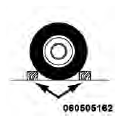1. Park the vehicle on a firm level surface, avoiding ice or slippery areas.
![]() WARNING!
WARNING!
Do not attempt to change a tire on the side of the vehicle close to moving traffic, pull far enough off the road to avoid the danger of being hit when operating the jack or changing the wheel.
2. Turn on the Hazard Warning flashers.
3. Set the parking brake.
4. Place the shift lever in PARK (automatic transmission) or REVERSE (manual transmission).
5. Turn Off the ignition.
6. Block both the front and rear of the wheel diagonally opposite the jacking position.
For example, if changing the right front tire, block the left rear wheel.

![]() NOTE: Passengers should not remain in the vehicle while the vehicle is being
jacked.
NOTE: Passengers should not remain in the vehicle while the vehicle is being
jacked.
See also:
Failure Indications
A malfunction of the Rear Park Assist sensors or system is indicated, during
REVERSE gear engagement, by the instrument panel warning icon.
The warning icon is illuminated and a message is displa ...
MP3 File Reading
Track Skips While Playing Mp3 Files
The CD is scratched or dirty.
The Duration Of The Mp3 Tracks Is Not Correctly Displayed.
In some cases (due to the recording mode) the duration of the MP3 tracks ...
Vehicle Modifications/Alterations
WARNING!
Any modifications or alterations to this vehicle could seriously affect its
roadworthiness and safety and may lead to an accident resulting in serious injury
or death. ...


